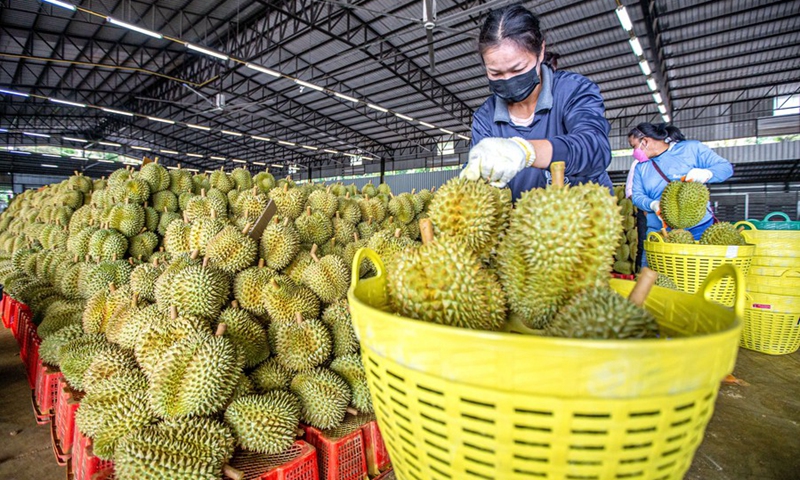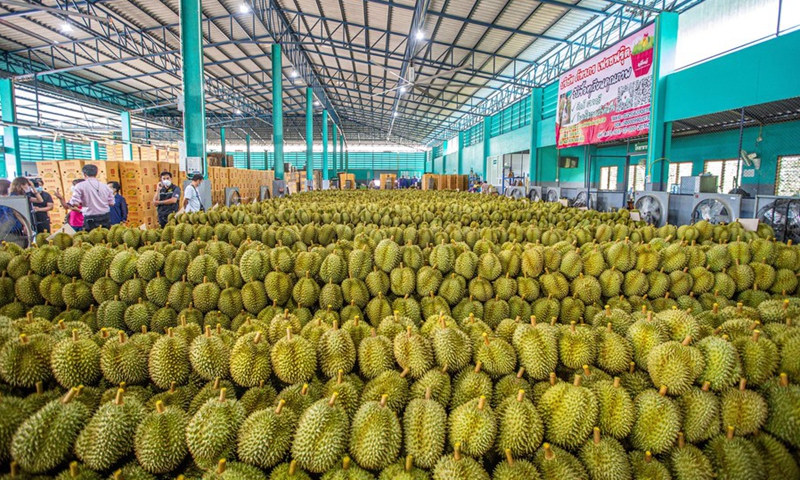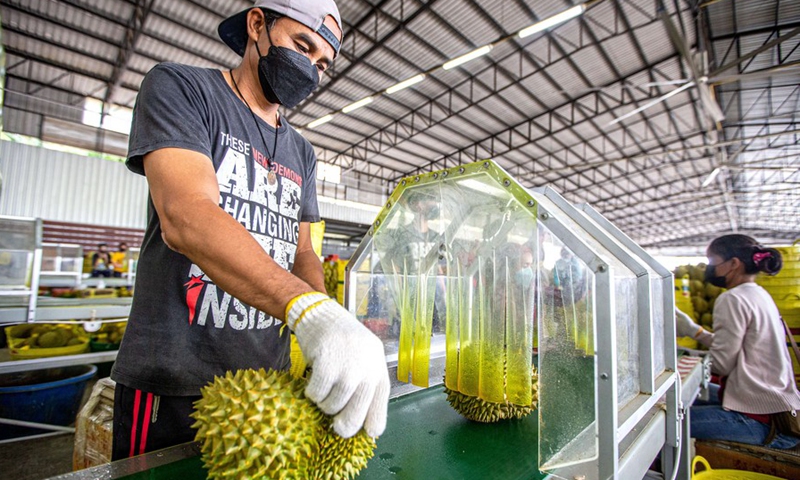
Workers sort durians at a durian processing factory in Chanthaburi Province, Thailand, May 5, 2022.(Photo: Xinhua)

Photo taken with a drone shows a durian orchard in Chanthaburi Province, Thailand, May 5, 2022.(Photo: Xinhua)

Photo taken on May 5, 2022 shows durians at a durian processing factory in Chanthaburi Province, Thailand.(Photo: Xinhua)

A worker disinfects a durian at a durian processing factory in Chanthaburi Province, Thailand, May 5, 2022.(Photo: Xinhua)
A young man climbed barefoot on a meters-tall tree, slashed the stalk with a knife to pick durian, and then threw the fruit at Silaphon Thongrot, owner of the Miiw's durian orchard in Thailand.
From March to July each year, Thai durian farmers are all geared to address China's craving for the football-sized and thorny fruit.
"When durian season is in full swing, up to 8,000 durians are picked in one day," Silaphon said while catching a durian flying towards her from a durian tree.
Located in the Chanthaburi province, the renowned fruit capital of Thailand, Silaphon's orchard is home to hundreds of durian trees with dozens of fruit on each of them. For its distinctive shape, intensive smell and rich custard-like flavor, durian is also called the "king of fruits."
Currently, durians from Thailand are dominating the Chinese market. "Up to 100 percent of our durians are shipped to China, and the demand is increasing year by year," said Silaphon, who has managed her family's durian orchard for around 15 years.
"We also export a small amount of durian to Japan, Australia and South Korea, but these markets are still very small compared to the amount exported to China," she added.
China's annual durian imports rose almost fourfold from 2017 to 2021, a skyrocketing trend that provides great opportunities for the Thailand-China fruit trade.
This pattern is likely to be further fueled by the implementation of the Regional Comprehensive Economic Partnership (RCEP) agreement, the world's largest free trade deal to date, and the rapidly evolving transportation infrastructure in the region.
This year the first ASEAN (the Association of Southeast Asian Nations) fruit train arrived in Pingxiang, southern China's Guangxi Zhuang Autonomous Region, in January and the first "Durian Express" reached the southern Chinese city of Guangzhou in April. Moreover, the China-Laos railway made it possible for Thai fruits to be transported to China via road-rail link.
The diversified modes of transportation not only reduce the logistics costs, but also greatly shorten cross-border transportation time through measures like one-stop customs clearance.
By means of road-rail transport, the time and cost of exporting to China have been reduced by around 30 percent, said Aat Pisanwanich, director of the Center for International Trade Studies (CITS) at the University of the Thai Chamber of Commerce.
"If the rail-link from Thailand has been connected and completed, it is expected to help reduce time and cost of transportation by about 60 percent," he added.
Nuttakij Oranhirunruk, vice president of the Thai-Chinese Agribusiness Association, is full of confidence in the substantial growth of Thai durian exports to China this year, saying that the eastern agricultural zone is expected to export 35,000 containers this year, compared to 25,000 last year.
Nuttakij also runs a durian packing factory in Chanthaburi, where thousands of durians are neatly stacked, surrounded by hundreds of Chinese labeled cardboard boxes. After being sealed in the boxes and disinfected, the fruits will be on their way to China in a few days.
Despite the significant benefits brought by the RCEP, Thai durian will face fierce competition from neighboring countries. Malaysia's Musang King variety has gained numerous devotees in China in recent years.
Thai fruit exporters must prioritize sanitary standards and focus more on production quality to keep Thai durian at the forefront of Chinese consumers' minds, Aat said.
In Silaphon's plan, her orchard will be cultivating more high-quality varieties beside Monthong to meet diverse demands, and also set foot in e-commerce to expand sales in the Chinese market.■
